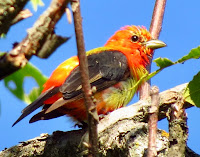From the archives: #6 Bug-inspired single-panel comic
Can't find the darn switch to turn the light on!
VT Bug Eyed Bug-inspired single-panel comics use photos and captions as touchpoints - the invertebrate society reaching out to the human society. Images from Nature. Captions and (their) story by Bernie Paquette.
A cartoon is a single drawing which communicates a moment in time, such as touchpoints on a customer journey, where empathy is important. Cartoons can tell you how people [or insects] are feeling. A cartoon adds emotional content. There’s a point of view represented — it could be yours, the artist’s or that of a real or created character. [The word "panel" may also refer to a cartoon consisting of a single drawing; the usage is a shortened form of "single-panel comic".]
Comics, cartoons, and illustrations can be an excellent way to deliver a message. They help people look at things (including themselves) differently.
From David Blumenstein (a service designer and cartoonist) at https://davidblumenstein.medium.com/illustrations-vs-cartoons-vs-comics-9babcc09f999
Vermont Cartoonist heads to his 1.3-acre yard to explore ties between cartoons and insects.
Observing invertebrates, especially insects - I call it inverting. The inverting movement is people seeing connections between all invertebrate life and ourselves. Tools such as iNaturalist, Seek, and bug-inspired comics help raise our awareness and empathy and most importantly encourage us to look closely at the life going on all around us - as close as in our backyards.
Watching insects eating, mating, pooping, cleaning themselves, warming up in the early morning, falling down then getting right back up, behaving as predators or prey, as meat eaters or vegetarians, seeking host plants or other animals to raise a family, defending their families, and all the unique ways each of the species goes about these aspects of life - gives us a perspective on how we go about the details of our daily lives.
And sometimes, how insects look or behave is beautiful, sometimes it is funny, sometimes it evokes an "OMG did you see that?".
What's so funny about insects?
Each Saturday VT Bug Eyed bug-inspired single-panel comics bring the Vermont insects, some of whom may live in your yard, to the forefront. The single-panel comics shoot for a laugh but also aim to inform, encourage your own observations in your yard, and entice thinking big about small life forms. The captions are the monologue of an insect with complex miniaturized bodily functions and life behaviors resulting in an oversized positive effect on the world as we know it today. It is about blowing up the insect image and breaking down the enormous diverse life of the planet's most underappreciated animals.
Each one tells a different story or provides a message or information about the taxa (genus or species).
 Was there an amphibious monster sighted in Richmond? See comic number 113 for evidence.
Was there an amphibious monster sighted in Richmond? See comic number 113 for evidence.
As comic number 132 (Darth Vader) states, "This will be a day long remembered. It has seen the end of many insects. Without flies, bees, and other pollinators, flowers will be no more. Unless mankind changes its ways!".
Number 129 speaks to the wisdom of the fly.
Number 126 Circus Act, tells of a spider's pride.
Number 118 Muck on the Menu fills us in on the taste of waste - we are lucky some insects eat our crap.
Start your Saturday with a morning beverage and VT Bug Eyed Insect-inspired comic, then get outside for inverting fun.
Did you enjoy the Fourth of July fireworks? View them nightly in your yard - they are called fireflies or lightning bugs of which there are about 150 species in the United States.
Ever heard of honey bees? They are not native to North America. What do you know about the approximately 350 species of bees native to Vermont? Did you know most of them are solitary bees and live most of their life underground, unlike honeybees who live year-round in hives?
It is easy to get to know your yard neighbors. Go outside and take a closer look, nature will entertain, fascinate, and entice you to find out more about the vast species of insects that live as close as your yard.
View a new comic every Saturday at Vtbugeyed.blogspot.com.
Bugs voted the cartoon "The Oldest in Vermont" as their favorite from the Seven Days Cartoon issue, (What's So Funny? Coloring Outside the Lines in the Cartoon Issue, July 10,2024). Nature not only deserves a closer look but also rewards those who look closely and attentively at animals and plants.
Which VT Bug Eyed Bug-inspired comic is your favorite?
My sister gets all the laughs!
Mama said, "Honey do you want people to laugh at your jokes like they do with your sister the cartoonist, or do you want folks to admire your beauty?"
Lead us to Nature
we will never again
be lost.
- Bernie























